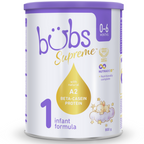Baby Feeding at 4 Months
By four months your baby will be really showing their personality. Some of their behaviours may be familiar, especially if you’ve had a baby before. Feeding patterns and frequency at four months generally reflect a baby’s growth. An increase in movement and energy means more kilojoules are needed to fuel their growth.
All your baby’s nutritional requirements have to come from milk alone at four months. You could find well meaning friends and family offering their advice about introducing your baby to solid foods. However, at four months a baby’s digestive system is still too immature to digest any food other than milk.
I Can Hear You
Babies at four months have found their voice and use any opportunity to show the world how clever they are. For the last couple of months the primary purpose of your baby’s mouth was to seek and get nutrition. Now a whole new range of vocal skills are emerging from that little person. Vocalisation is not restricted to playtime. At four months your baby is likely to goo and gaa, smile and even giggle when they’re feeding. Small interruptions are part of the whole feeding experience.
Remember.
You are feeding your baby’s body as well as their brain. Holding, nursing, cuddling and eye contact during feeds all help to support your four month old baby’s brain development. This is one of the reasons why prop feeding is not recommended. Laying a baby flat when feeding and leaving them alone can also cause ear infections and aspiration.
At around four months of age babies start to learn how to roll. This is generally from back to front first, and then a couple of weeks later, rolling from front to back. Your baby may want to practice this twisting and turning when they’re feeding but still attached to the breast or nipple. If your baby is too interested in moving around, give them a break from feeding for a little while and then try again. At four months it’s impossible to separate one behaviour from another, and feed times are not always a period of intense and undivided attention.
Look at your baby’s total feeding intake over 24 hours. Rather than focusing on each individual feed, understand that feeding behaviour is cumulative. Sometimes your baby will want more milk and other times less.
Five Tips for Feeding a 4 Month Old Baby
- Don’t confuse drooling for teething. At four months a baby’s salivary glands are getting ready for solid foods. Dribbling or drooling is common until they learn how to swallow their saliva.
- Breastfed babies often demand more frequent feeding at four months. Breastfeeding mothers can interpret this as a sign of low milk supply when generally, the cause is a rapid growth spurt.
- Distraction is common. By four months babies have learnt there is a world to discover, and they want to be part of it. If your baby is a busybody, try feeding in a quiet, distraction free place.
- Understand that milk alone is enough for a four month old baby. As long as they are having plenty of breastfeeds or formula, they don’t need any extra kilojoules from solid food.
- Try not to feed your four month old baby to sleep. It’s isn’t too early to teach them early skills in self soothing.
Expect Your 4 Month Old Breastfed Baby to
- Demand more frequent breastfeeds during the day and evening. Growth spurts are common at four months and the only way to fuel all that growth is through their milk intake.
- Know the parent who feeds them. At four months babies can show a preference for their breastfeeding mother because of the hours of feeding and physical closeness.
- Kick and move around when they’re feeding. While some babies are calm feeders, most four month olds can’t be still, even when they’re feeding.
Expect Your 4 Month Old Bottle Fed Baby to
- Want varying amounts of formula. Sometimes they may only want to “snack” and not finish their quota. Like adults, babies don’t have consistent needs for food volume.
- Push the teat out of their mouth when they’re finished feeding. They will also turn their head, close their lips and give very clear signals that they need a break or have finished.
- Show a preference for one particular type of teat and feed better with this.
- Be less keen to feed when they’re tired or distracted so try to be flexible.
- Need around 120mls of formula per kilogram of their body weight per day. So if your four month old weighs 6.5 kgs they’ll need around 780 mls/day – 130 mls over 6 feeds.
Five General Tips for Feeding Your 4 Month Old Baby
- Try not to rush feeding times. Whether breast or bottle fed, your baby will benefit from feeding at their own pace.
- Be aware that changes in feeding can be a sign of illness. Sleepy feeds, fussiness, vomiting and not wanting to feed are all signs that warrant a medical check.
- Need their nappy changed before and perhaps midway during feed times. Do what you can to make your baby as comfortable as possible when they’re feeding.
- Make sure you prepare the formula exactly as recommended by the manufacturer. Formula which is too strong can cause constipation and tummy upsets. Formula which is too dilute won’t satisfy your baby’s hunger and could impact on their growth.
Check with your child health nurse for advice and guidance on your four month old baby’s individual feeding needs.
